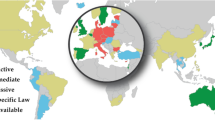Abstract
The term “stem cell exceptionalism” has been used to characterize the policy response to controversies surrounding human embryonic stem cell research. For example, governments and funding agencies have adopted policies governing the derivation and use of human embryonic stem cell lines. These policies have effectively served to fill gaps in existing guidelines and regulations and signal that scientists are committed to a responsible framework for the conduct of research involving human embryos. Recent publications discuss whether ethical and policy issues associated with induced pluripotent cells (iPSCs) from non-embryonic sources create a need for further policy intervention. We suggest many of the issues identified by commentators may be addressed through the application of established policy frameworks governing the use of tissue, human stem cells, and research participation by human research subjects. To the extent, iPSC research intersects with hESC research (e.g. the creation of human gametes and/or embryos), the policy framework governing hESC appears sufficiently robust at this time.
Similar content being viewed by others
References
Snead, O. (2005). Preparing the groundwork for a responsible debate on stem cell research and human cloning. New England Law Review, 39, 479.
Stayn, S. (2006). A guide to state laws on hESC research and a call for interstate dialogue. Medical Research Law & Policy, 05(21), 718–725.
Sage, W. (2010). Will embryonic stem cells change health policy? Journal of Law, Medicine & Ethics, Law, Science and Innovation: The Embryonic Stem Cell Controversy, summer.
NAS. (2005). Guidelines for human embryonic stem cell research. IOM National Research Council (U.S.). Committee on Guidelines for Human Embryonic Stem Cell Research. Washington: The National Academies Press.
Robertson, J. (2010). Embryo stem cell research: ten years of controversy. Journal of Law, Medicine & Ethics, Science and Innovation: The Embryonic Stem Cell Controversy, Summer.
Lo, B., Parham, L., et al. (2010). Cloning mice and men: prohibiting the use of iPS cells for human reproductive cloning. Cell Stem Cell, 6(1), 16–20.
Caulfield, T., Scott, C., et al. (2010). Stem cell research policy and iPS cells. Nature Methods, 7(1), 28–33.
Aalto-Setala, K., Conklin, B. R., et al. (2009). Obtaining consent for future research with induced pluripotent cells: opportunities and challenges. PLoS Biology, 7(2), 204–208.
Zarzeczny, A., Scott, C., et al. (2009). iPS cells: mapping the policy issues. Cell, 139(6), 1032–1037.
Sugarman, J. (2008). Human stem cell ethics: beyond the embryo. Cell Stem Cell, 2(6), 529–533.
Condic, M. L., & Rao, M. (2008). Regulatory issues for personalized pluripotent cells. Stem Cells, 26(11), 2753–2758.
Gunsalus, C. K., Bruner, E. M., et al. (2006). Mission creep and the IRB world. Science, 312(5779), 1441.
Kawakami, M., Sipp, D., & Kato, K. (2010). Regulatory impacts on stem cell research in Japan. Cell Stem Cell, 7:6(5), 415–418.
Fink, D. W., Jr. (2009). FDA regulation of stem cell-based products. Science, 324(5935), 1662–1663.
Carpenter, M. K., Frey-Vasconcells, J., et al. (2009). Developing safe therapies from human pluripotent stem cells. Nature Biotechnology, 27(7), 606–613.
Rao, M., & Condic, M. L. (2009). Musings on genome medicine: is there hope for ethical and safe stem cell therapeutics? Genome Medicine, 1(7), 70.
Lau, D., et al. (2008). Stem cell clinics online: the direct-to-consumer portrayal of stem cell medicine. Cell Stem Cell, 3(6), 591–594.
CIRM (2011). Ethical and Policy Considerations for A Pluripotent Stem Cell Resource Center 2011 Update. Available at http://www.cirm.ca.gov/files/MeetingReports/SWG_April_2011_6_28_2011.pdf (accessed July 19, 2011).
Mascalzoni, D., Hicks, A., et al. (2008). Informed consent in the genomics era. PLoS Medicine, 5(9), 1302–1305.
Helft, P. R., Champion, V. L., et al. (2007). Cancer patients’ attitudes toward future research uses of stored human biological materials. Journal of Empirical Research on Human Research Ethics, 2(3), 15–22.
Malin, B., & Loukides, G. (2011). Identifiability in biobanks: models, measures, and mitigation strategies. Hum Genet. 2011 Jul 8. [Epub ahead of print].
Baylis, F. (2008). Animal eggs for stem cell research: a path not worth taking. The American Journal of Bioethics, 8(12), 18–32.
Winickoff, D. E., & Winickoff, R. N. (2003). The charitable trust as a model for genomic biobanks. The New England Journal of Medicine, 349, 1180–1184.
Holm, S. (2006). Who should control the use of human embryonic stem cell lines: a defense of the donors’ ability to control. Bioethical Inquiry, 3, 55–68.
Wendler, D. (2006). One-time general consent for research on biological samples. BMJ, 332(7540), 544–547.
Simon, C., & L’Heureux, J. (2011). Active choice but not too active: Public perspectives on biobank consent models. Genetics in Medicine, Published Ahead-of-Print.
Caulfield, T. (2007). Biobanks and blanket consent: the proper place of the public good and public perception rationales. Kings Law Journal, 18, 209–226.
Presentation by Chris Hempel PRIM&R Advancing ethical research conference Tuesday December 7, 2010. Also, see http://addiandcassi.com/.
UNESCO (2003) International declaration on human genetic data. United Nations Educational, Scientific, and Cultural Organization and ESHG. Eur J Hum Genet, 11(Suppl 2), S8–10.
National Cancer Institute. (2007). National Cancer Institute best practices for biospecimen resources.
National Institutes of Health. (2009). National Institutes of Health guidelines on human stem cell research.
Rothstein, M. A. (2007). Genetic exceptionalism and legislative pragmatism. The Journal of Law, Medicine & Ethics, 35(2 Suppl), 59–65.
Caulfield, T., Zarzeczny, A., et al. (2009). The stem cell research environment: a patchwork of patchworks. Stem Cell Review and Reports, 5(2), 82–88.
Acknowledgments
The authors would like to acknowledge the time and effort taken by the reviewers to proved comprehensive comments.
Author information
Authors and Affiliations
Corresponding author
Rights and permissions
About this article
Cite this article
Lomax, G.P., Peckman, S.R. Stem Cell Policy Exceptionalism: Proceed with Caution. Stem Cell Rev and Rep 8, 299–304 (2012). https://doi.org/10.1007/s12015-011-9305-z
Published:
Issue Date:
DOI: https://doi.org/10.1007/s12015-011-9305-z




